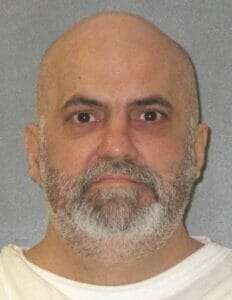Billy Ray Irick was executed by the State of Tennessee for the sexual assault and murder of a seven year old girl. According to court documents Billy Ray Irick was living with the victims, Paula Dyer, for over a year at the time of her murder. Billy Ray Irick would murder the seven year old girl after sexually assaulting her. Billy Ray Irick would be executed by lethal injection on August 9, 2018
Billy Ray Irick More News
Billy Ray Irick felt searing pain akin to torture before he died in a Tennessee prison in August, but steps taken before his execution blocked signs of suffering, according to a doctor who reviewed information about the lethal injection.
Dr. David Lubarsky’s statement is included in a new court filing entered late Thursday amidst an ongoing legal challenge of Tennessee’s lethal injection protocol. He wrote that Irick “experienced the feeling of choking, drowning in his own fluids, suffocating, being buried alive, and the burning sensation caused by the injection of the potassium chloride.”
The documents also state Tennessee failed to follow its own protocol during Irick’s execution, raising questions about whether executioners ever intended to ensure Irick was unable to feel the pain caused by the second and third lethal injection drugs.
Irick and 32 other death row inmates sued the state this year arguing that Tennessee’s new protocol for lethal injections would subject them to pain so intense it would violate the U.S. Constitution. They questioned the use of midazolam, the first of the three drugs the state administers during executions.
Lubarsky, a Florida doctor, testified for the inmates during a two-week trial in July. He said midazolam, which is supposed to render inmates unconscious and unable to feel pain, doesn’t work as intended. He said midazolam sedates inmates but does not stop them from feeling the effects of the other two drugs, vecuronium bromide and potassium chloride.
Lubarsky said statements from people who witnessed Irick’s execution indicated the controversial drug midazolam failed to ensure Irick could not feel pain during his death.
Irick, 59, was executed for the rape and murder of 7-year-old Paula Dyer in Knox County. He was convicted of the crime in 1986.
Lubarsky and other medical experts are the backbone for the inmates’ lethal injection appeal. The case is not about whether the death penalty is constitutional, attorneys for the death row offenders wrote in the 390-word brief. It’s about what the deadly drugs do to a body, and whether Tennessee citizens should approve of that likely tortuous outcome.
“This case is about whether it is constitutional to inject a human with a small bottle of acid—which will destroy the lining of their lungs and cause them to drown in blood—and then to inject them with a paralytic that will leave them conscious but expressionless—unable to speak or scream—feeling as if they are buried alive, and finally to stop their heart with an injection that will, in their last minute of life, cause them to chemically burn alive,” wrote Kelley Henry and other federal public defenders working on behalf of the death row inmates.
Davidson County Chancery Court Judge Ellen Hobbs Lyle agreed Lubarsky and other experts were well qualified, but she rejected their arguments in ruling against the inmates.
Lyle said whatever pain the inmates felt did not last long enough to count as unconstitutional torture, a stance blasted by U.S. Supreme Court Justice Sonya Sotomayor in an opinion issued hours before Irick’s death.
The remaining death row offenders continue to pursue their appeal of Lyle’s ruling even though no court stopped Irick’s execution.
The Tennessee Department of Correction, represented by the Office of the Tennessee Attorney General, argued it is following the law and using drugs available to carry out the required punishment for death row offenders. Department officials noted during trial that the U.S. Supreme Court previously allowed executions using midazolam to proceed, arguing the usage is now case law.
In the latest filing though, Henry and the other attorneys argue that case law is not settled. They point to new and more expansive medical evidence, presented to Lyle during the trial, that has never been considered by the full Supreme Court.
They also blast the state’s arguments in the new filing, writing: “Defendants’ repeated mantra, barely acceptable from a teenager, is that — ‘all the other states are doing it, so it must be ok.'”
Department spokeswoman Neysa Taylor declined to comment, citing the ongoing litigation.
The protocol for how the state puts an inmate to death is very specific.
It requires the state prepare primary and back-up syringes for each of the drugs used in the lethal injection.
However, documents obtained by the inmates’ attorneys show executioners did not prepare a back-up dose of midazolam. The report says executioners only prepared the one dose of midazolam used at 7:28 p.m., essentially the same time Irick’s execution began.
The protocol requires the executioner to inject the midazolam into a tube that runs into the condemn’s arm. After some time, the warden — who is in the execution chamber — is required to check to see if the condemned is conscious.
If the condemned is conscious, the state protocol requires injecting a second dose of midazolam.
Riverbend Maximum Security Institute Warden Tony Mays conducted the consciousness check: he brushed Irick’s eyelids, yelled his first name twice and appeared to grab his shoulder. If he had determined Irick was conscious though, it’s unclear if the state could have or would have prepared another midazolam syringe.
“If Mr. Irick had responded to the consciousness assessment or there had been problems with the IV apparatus, the execution team would not have been prepared to carry out the contingency procedures in the manual,” Henry and the attorneys write.
“Defendants’ failure to follow the procedures in the manual indicates that the protocol is meaningless for purposes of Defendants’ carrying out an execution and therefore creates a substantial risk of severe pain and suffering for Plaintiffs,” the document says
Throughout his statement, Lubarsky said witness statements from Irick’s execution supported the inmates’ legal arguments. Lubarsky said he was convinced “to a reasonable degree of medical certainty” that Irick was not properly anesthetized during his execution. Any inmate not properly rendered unconscious and insensate would feel the “torturous effects of the lethal injection process,” Lubarsky said.
Witnesses described Irick choking, snoring, gulping and gasping for air as the drugs were administered. They also said he jolted and appeared to push against the restraints at one point.
Lubarsky noted that Irick’s hands were taped to the gurney during the execution. His fingers were wrapped with a tape-like substance that prevented movement and limited visibility of the majority of his hands.
Lubarksy said the tape blocked prison officials from seeing important signs that Irick was aware of his surroundings throughout the execution.
“A trained observer knows that if a patient moves his fingers or hands that is a clear indicator that that they are not anesthetized,” Lubarsky wrote. “The taping of Mr. Irick’s hands affirmatively prevented the Warden from observing an important indicator that Mr. Irick was not anesthetized.”
Tennessee courts denied all of Irick’s legal requests, and appear poised to do the same ahead of the state’s next execution.
The Tennessee Supreme Court recently evoked a rare legal move to set the schedule for the lethal injection challenge within the Court of Appeals. The schedule is condensed, leaving far less time for attorneys to prepare their case compared toa typical appeal.
State Supreme Court Justice Sharon Lee admonished her colleagues after they set the schedule, calling it a “rocket docket” that jeopardized inmates’ chances for a fair trial.
In the new filing, attorneys ask the court to delay the appellate process.
Edmund Zagorksi, 63, is scheduled for execution on Oct. 11. He was convicted in 1984 of robbing and shooting John Dotson, of Hickman County, and Jimmy Porter, of Dickson, before slitting their throats, according to Tennessean archives.
https://www.tennessean.com/story/news/crime/2018/09/07/tennessee-execution-billy-ray-irick-tortured-filing/1210957002/
Billy Ray Irick Other News
Witnesses entered the execution viewing chamber at 6:43 p.m., where prison officials turned out the lights until the blinds to the glass were lifted.
“I’m here first and foremost for the victim Paula Dyer and for the citizens of Knox County, the same citizens that convicted him and sentenced him to death,” Jones said. “I wanted to hear some more from him. You’re always looking for that explanation.”
Shiles and Sutherland left the viewing room at 7:12 p.m., presumably to go into the execution chamber and observe Irick’s IV being administered.
When the two men returned to the observation room around 7:25 p.m., Shiles told witnesses that he kissed Irick and touched him.
Moments later, after the blinds lifted and Irick made his statement, the administration of a combination of powerful and deadly drugs commenced.
Family members of Paula watched in a separate room off the execution chamber that was visible to other witnesses, including the media witnesses. One man leaned up close to the glass and bit his nail. A woman had her face pressed almost to the window.
First the executioner injected Irick with midazolam, a drug intended to render Irick unconscious.
After Riverbend Warden Tony Mays determined Irick was unconscious, the executioner injected vecuronium bromide and potassium chloride, drugs intended to stop Irick’s lungs and heart.
Both the man and the woman leaned back as it appeared Irick had stopped breathing.
Around the country, death row offenders have writhed, screamed, groaned and gasped as lethal injection drugs take longer than expected to work — or don’t work at all.
At least twice in Ohio, the state had to call off executions after prison staff could not find a viable vein for the intravenous injection of the drugs.
Irick was a heavy-set man. Tennessee does not change its execution protocol depending on the body type of the condemned. But midazolam has a different effect on different people.
Before his death, Irick ate his last meal: a burger, onion rings and a Pepsi soft drink. Shiles said earlier Thursday that Irick was in good spirits and understood he would be executed.
Irick lived with Paula Dyer’s mother and stepfather, Kathy and Kenny Jeffers, in 1985. Although the family allowed the then-26-year-old Irick to live with them for some time, years after the crime they reported he exhibited signs of mental illness.
Kathy Jeffers was among the small group of Paula’s family members seen quietly coming and going from Riverbend Maximum Security Institute on Thursday evening, walking out after the execution with a tissue in her left hand.
She and other family members chose not to speak at a news conference held afterward outside the prison.
Jeffers had warned her husband she didn’t want to leave the children with Irick the night of Paula’s killing, that she’d seen him muttering to himself in a half-drunk rage on the porch before she left for work.
Court records show the family reported Irick heard voices and was “taking instructions from the devil.” He also reportedly chased after a young girl while carrying a machete in Knoxville in the days proceeding Paula’s death.
On April 15, 1985, Irick called Kenny Jeffers to say Paula would not wake up.
Her parents found Paula dead on their bed. An autopsy showed she died of asphyxiation. Irick initially tried to hitchhike out of town, but was caught by police the day after Paula’s death.
Thursday night following the execution, Tennessee Attorney General Herbert H. Slatery III released a statement declaring that “justice was finally served” for the murder and rape of Paula.
“I hope tonight’s lawful execution in some way eases the heartache Paula’s family has lived with and brings a degree of closure to a chapter of their lives that has been indescribably difficult.”
Before and during his 32 years on death row, Irick repeatedly attempted to convince courts he was too mentally ill to be executed or that the drugs set for use in a lethal injection would violate his constitutional right not to be tortured to death.
While courts did delay his execution several times, most recently in 2014, no court decided to weigh in to prevent his death this time.
“I thought somebody would actually look at the facts,” Shiles said Thursday just before the execution, referring to evidence supporting Irick’s mental illness. “I was wrong.”
Roughly five hours before Irick’s death, U.S. Supreme Court Justice Elena Kagan denied his request to delay his execution. But fellow Supreme Court Justice Sonia Sotomayor blasted the decision not to delay the execution while the state reviewed its lethal injection method.
“In refusing to grant Irick a stay, the Court today turns a blind eye to a proven likelihood that the state of Tennessee is on the verge of inflicting several minutes of torturous pain on an inmate in its custody, while shrouding his suffering behind a veneer of paralysis,” Sotomayor wrote in her dissent.
“I cannot in good conscience join in this ‘rush to execute’ without first seeking every assurance that our precedent permits such results … if the law permits this execution to go forward in spite of the horrific final minutes that Irick may well experience, then we stopped being a civilized nation and accepted barbarism.”
Thursday afternoon, Catholic bishops in Nashville and Knoxville noted Pope Francis’ recent rebuke of the death penalty to condemn Irick’s execution.
“The state has the obligation to protect all people and to impose just punishment for crimes, but in the modern world the death penalty is not required for either of these ends,” wrote Bishop Richard F. Stika of Knoxville and J. Mark Spalding of Nashville.
It’s unclear what impact Irick’s execution will have on a pending legal challenge to the state’s lethal injection protocol.
Irick joined 32 other death row inmates in a lawsuit arguing the three drugs Tennessee uses for lethal injections would violate their constitutional right to not be tortured to death. Experts at a trial in Davidson County argued the first drug, midazolam, does not always work as intended to render an offender unconscious and unable to feel pain.
If the midazolam does not work, then the second and third drugs will cause pain similar to being burned alive and drowned, argued experts and attorneys for the death row offenders.
Davidson County Chancellor Ellen Hobbs Lyle agreed the condemned may feel pain as he or she dies, but noted there is no legal right to a painless death.
She rejected the inmates’ lawsuit, prompting an appeal to the Tennessee Supreme Court. Citing a procedural bar for the first time, a majority of the state’s high court determined the inmates had a low chance at succeeding and therefore Irick’s execution should not be delayed.
“By applying the law and requiring satisfaction of this legal standard, we are not ‘rush(ing) to execute’ Mr. Irick. In fact, this suggestion is astonishing, actually, given that Mr. Irick was convicted and sentenced 32 years ago and has obtained multiple stays over the years,” the four-member majority wrote in a footnote of their opinion.
n a relatively unusual move, Justice Sharon Lee dissented.
“The harm to Mr. Irick of an unconstitutional execution is irreparable,” Lee wrote in a forceful break with the majority. “Yet the harm to the State from briefly delaying the execution until after appellate review is minimal, if any.”
Immediately after the state Supreme Court’s decision, Gov. Bill Haslam also announced he would not intervene.
“My role is not to be the 13th juror or the judge or to impose my personal views, but to carefully review the judicial process to make sure it was full and fair,” Haslam said in a news release earlier this week. “Because of the extremely thorough judicial review of all of the evidence and arguments at every stage in this case, clemency is not appropriate.”
In January, the Tennessee Supreme Court scheduled an Oct. 11 execution for Edmond Zagorski and a Dec. 11 death date for David Earl Miller.
https://www.tennessean.com/story/news/crime/2018/08/09/billy-ray-irick-tennessee-execution-lethal-injection/830253002/









